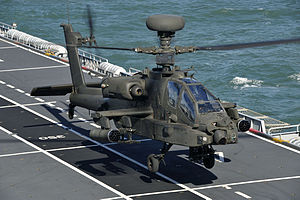Westland WAH-64 Apache
| Apache AH1 | |
|---|---|
 |
|
| Taking off from HMS Ocean in 2009 | |
| Role | Attack helicopter |
| National origin | United States / United Kingdom |
| Manufacturer |
Westland Helicopters/AgustaWestland (under licence) Finmeccanica (Leonardo since 2016) |
| Introduction | 2004 |
| Status | In service |
| Primary user | Army Air Corps |
| Produced | 1998–2004 |
| Number built | 67 |
| Program cost | £4.1 billion |
| Unit cost |
£35 million
|
| Developed from | Boeing AH-64D Apache Longbow |
|
|
| Images | |
|---|---|
|
|
|
| Video | |
|
|
|
|
The AgustaWestland Apache is a licence-built version of the AH-64D Apache Longbow attack helicopter for the British Army's Army Air Corps. The first eight helicopters were built by Boeing; the remaining 59 were assembled by Westland Helicopters (now part of Leonardo) at Yeovil, Somerset in England from Boeing-supplied kits. Changes from the AH-64D include Rolls-Royce Turbomeca engines, a new electronic defensive aids suite and a folding blade mechanism allowing the British version to operate from ships. The helicopter was initially designated WAH-64 by Westland Helicopters and was later designated Apache AH Mk 1 (often shortened to Apache AH1) by the Ministry of Defence.
The Apache was a valued form of close air support in the conflict in Afghanistan, being deployed to the region in 2006. The Apache has been an object of controversy over the fitting of some munitions, such as cluster bombs and thermobaric weapons. Naval trials and temporary deployments at sea have proven the aircraft as an able platform to operate from the decks of ships, which is a unique application of the Apache amongst its operators. British Apaches served in the NATO 2011 military intervention in Libya operating from Royal Navy ships.
...
Wikipedia
